Genovese Basil
Quick links to save you time
Why grow Basil?
Basil is suitable for many things. It enhances dishes, has health advantages, and is simple to cultivate.
- Flavor: Basil has a mildly spicy and sweet taste, making it a favorite in numerous recipes.
- Easy to grow: Growing Basil from seeds is straightforward; you can cultivate it in containers or the garden.
- Companion plant: It is a superb companion plant, warding off pests while drawing helpful insects to your garden.
- Health benefits: Basil contains antioxidant, anti-inflammatory, and antibacterial properties and packs essential nutrients.
- Variety: There are numerous basil varieties, each with a distinct flavor and look.
- Cost-effective: Cultivating Basil yourself can save you money and ensure you always have fresh herbs available.
- Freshness: Plucking fresh basil leaves from your garden or windowsill can enhance your meals with a vibrant and tasty flair.
- Ornamental: with its appealing appearance, Basil can be a decorative feature in your garden or windowsill.
- Bee-friendly: Basil flowers draw bees and various helpful insects to your garden.
- Harvesting: You can easily harvest Basil by snipping the whole stem just above a leaf pair, encouraging the growth of new shoots.
Which is the Best Basil Variety to Grow?
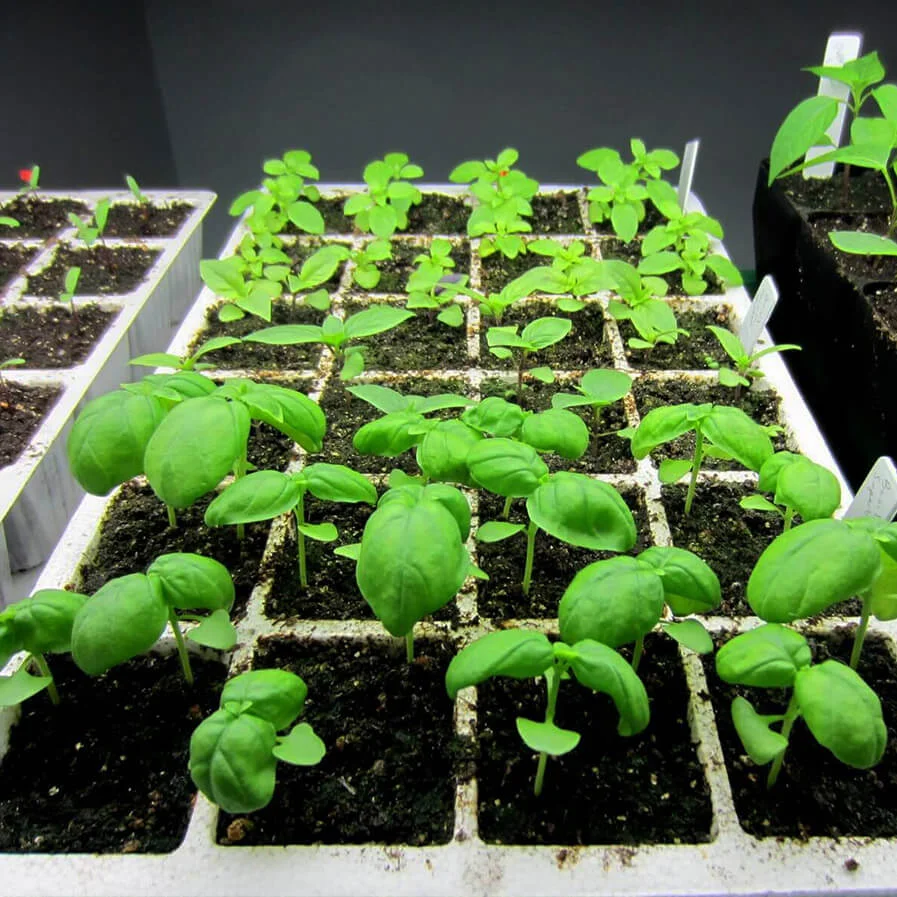
Basil seedlings
Selecting the best basil variety for cultivation depends on your taste, intended purpose, and growth conditions.
- Sweet Basil: This basil variety is the most common and frequently utilized, with a spicy clove taste crucial for numerous recipes like pesto. It’s straightforward to cultivate and fits into many recipes.
- Genovese Basil: This type of sweet Basil is excellent in pesto dishes. It has large, cup-like leaves and tends to bolt less quickly than other basil varieties.
- Thai Basil: This version has purplish stems, yielding elongated stalks with striking purple blossoms. Its taste offers a hint of licorice or anise, excellent for curries and stir-fries.
- Lemon basil: This type has a crisp citrus aroma and subtle lemon taste, making it ideal for teas, marinades, and salad dressings.
- Cinnamon basil: This type has an intense smell and robust flavor, perfect for enhancing salad dressings, sauces, soups, and stews.
- Dark opal basil: This type features dark purple leaves and a mildly spicy taste, excellent for salads and garnishing.
- Greek Basil: This type has petite leaves and a gentle flavor, which is ideal for salads and garnishing.
- Italian large-leaf Basil: This traditional variety features the largest leaves among all basil types and has a sweet, mild taste, making it a kitchen favorite.
Essential Points for Growing the Best Basil

Different types of Basil
- You need well-drained and fertile soil or substrate with a pH of 6.0 to 7.0.
- Check your soil’s quality or enhance it by incorporating abundant organic nutrients such as compost, blood meal, or cottonseed meal.
- When planting in a container, choose a large pot to prevent the plants from dehydrating rapidly during warm conditions.
- Place basil seeds or start transplants in a spot where they’ll receive 6 to 8 hours of sunlight daily.
Arrange Basil as the label indicates, typically spacing them 12 to 18 inches apart (31 to 46 cm) - Plant the seeds 1/8 inch deep, and once they sprout, thin them to a spacing of 3 to 4 inches (8 to 10 cm)
The plants grow within 10-14 days. - Basil flourishes in damp soil, so monitor the moisture frequently and water thoroughly when the top inch feels dry.
Consistently water basil, providing 1½ inches weekly to ensure robust growth. - The need for water varies based on soil composition and temperature conditions.
- Drip irrigation systems are adequate for watering basil plants.
Care and Maintenance
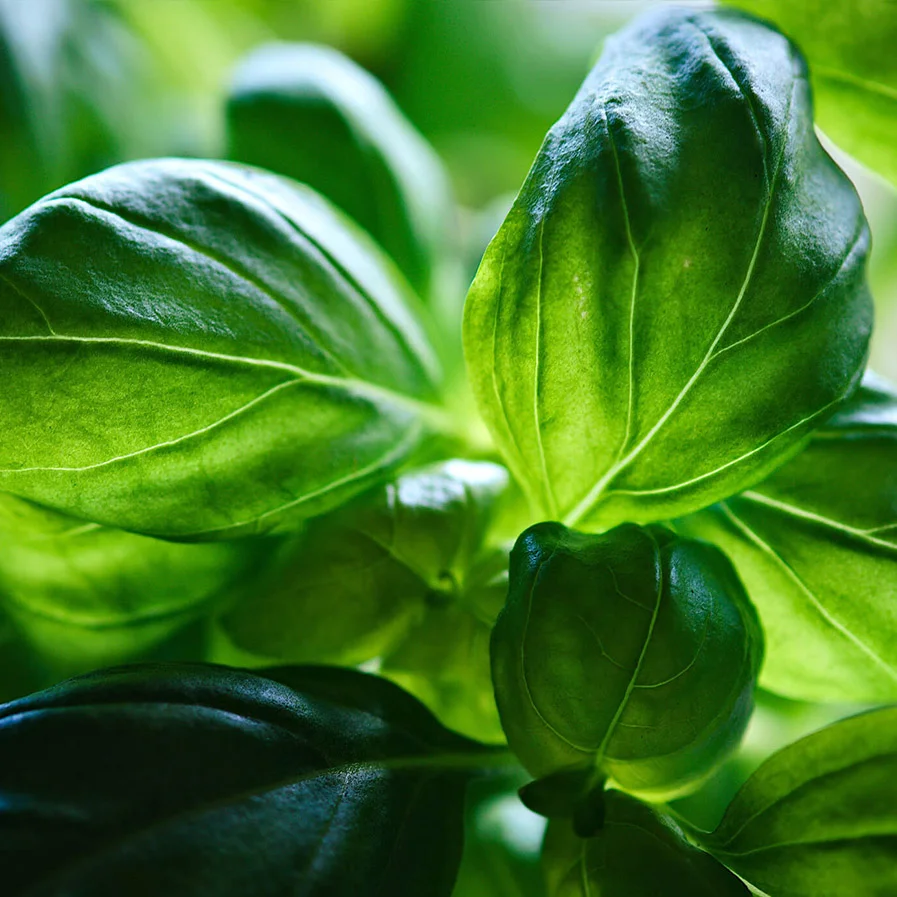
Basil
- When basil plants reach a height of 4 to 6 inches or 15 cm, remove the uppermost branches to encourage additional side growth and a generally taller plant.
- Make sure to remove the flowers to stop your plant from seeding.
- Boost leaf growth in Basil by nourishing it with a water-soluble plant fertilizer.
Incorporate a slow-release organic fertilizer during your basil planting and then supplement with a kelp meal liquid feed monthly. - Basil requires some additional nitrogen for rapid leaf growth.
When the plants are ready for harvest, enhance them with organic or general-purpose liquid nitrogen by adding 1-2 tablespoons of fertilizer for every 10 feet (roughly 3.3 m) of row every 2-3 weeks. - Once Basil reaches a height of 6 to 8 inches (20 cm), you can harvest leaves by plucking them off at any time.
Trim the stem, leaving just 2 to 4 leaves intact. - Once the seedlings display their initial six leaves, cut back to just above the second pair. This practice prompts the plants to branch out, yielding more leaves to gather.
- If a freeze looms, shield your plants from frost using row covers.
Lifespan
Basil is an annual herb that finishes its life span in a single growing season. But, with the proper care, It can yield leaves over many months.
Common Mistakes When Growing Basil
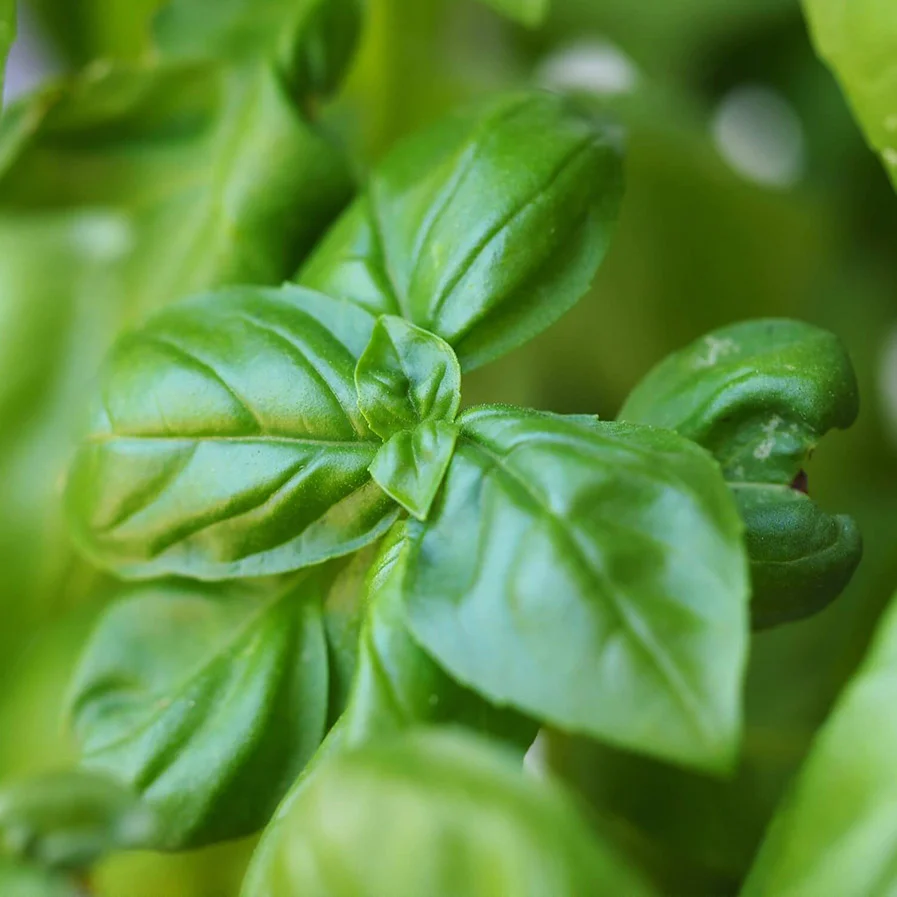
Basil
Now that we know what to do, let’s discuss what not to do.
- Over-fertilizing: Over-fertilizing basil can lead to rapid growth, producing elongated plants with inferior leaves. Always adhere to the fertilizer packaging guidelines and avoid using more than advised.
- Temperature fluctuations: Basil reacts to temperature changes, especially sudden drops. It thrives in warmer conditions, so it’s best to plant it after the risk of frost is gone to prevent elongated growth following a chilly spell.
- Insufficient sunlight: Basil needs at least 6-8 hours of direct sunlight daily. Insufficient lighting, often a challenge with indoor Basil, can lead the plants to grow tall and thin as they search for additional light. Trim them and relocate to a sunnier spot; the subsequent growth should be regular.
- Improper watering: Watering excessively or having poor drainage can lead to root rot, making leaves droop and stems turn soft. While Basil prefers damp soil, monitoring the moisture regularly and water thoroughly when the top inch dries out is essential.
- Harvesting incorrectly: Picking the largest basil leaves, especially those on the lower branches, can render the plant tall and sparse. These substantial leaves are pivotal for the plant, capturing the most sunlight and supplying nutrients to the rest. Collect leaves from the top to ensure a thriving basil with consistent new growth.
- Leaving flowers: Flowers can cause Basil to adopt a bitter taste and diminish the herb’s strength. The Basil’s flavor and strength are optimal right before flowering. While consumption remains an option, the leaf production rate slows, leading to slightly rougher and less flavorful herbs.
- Starting too early: Basil thrives as a warm-season herb, ideally in 80-degree temperatures. A standard error among gardeners is transplanting their Basil too early in the season. If there’s a sudden cold snap in spring, protect your delicate Basil with tools like row covers, mini hoop tunnels, or cloches until conditions get better.
- Not pruning enough: Regularly trimming Basil contributes to a more robust and fuller plant than a stretched or thin one. Nipping off new growth at the plant’s top using your finger and thumb when the herbs are still young benefits their overall development.
Is pruning basil necessary?
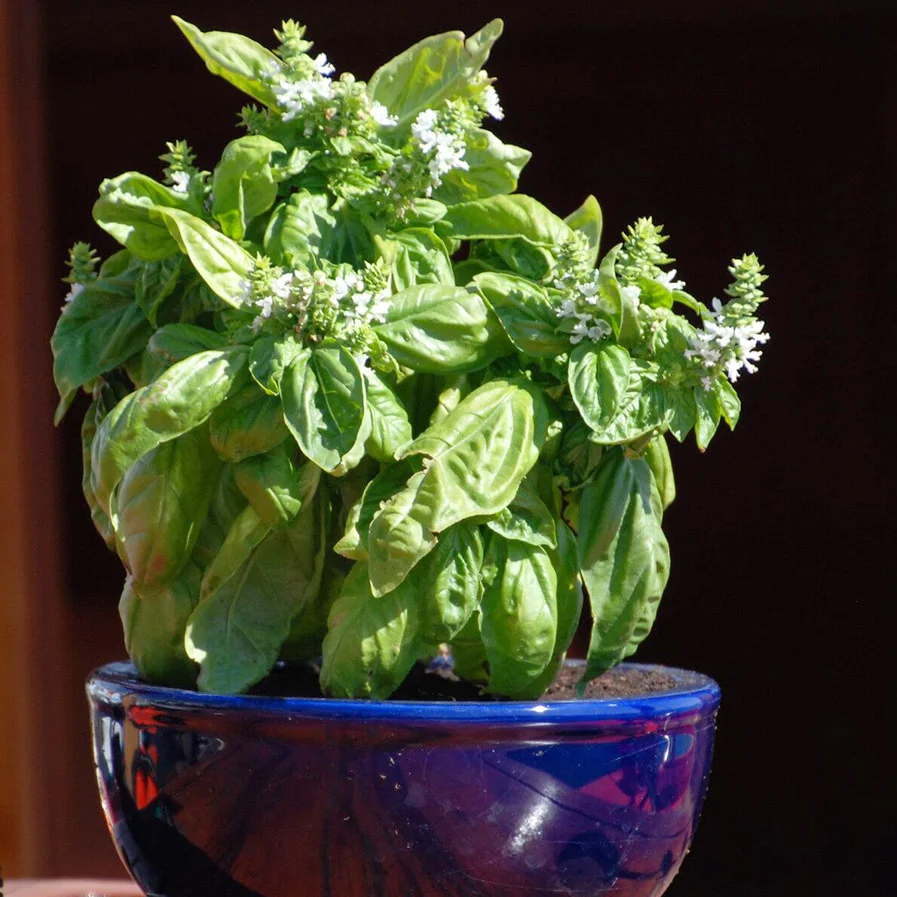
Basil in a Container
Absolutely, pruning basil is essential for fostering robust growth and boosting yields. Consistent trimming stimulates the emergence of soft new leaves and keeps the plant from growing tall and thin.
When to prune Basil
You can begin pruning once the young basil plant grows 6-8 inches (about 20cm). Regularly harvesting Basil boosts its productivity and guarantees optimal flavor.
Trim Basil every 2-3 weeks to foster abundant growth.
Pluck basil leaves in the morning, when their essential oils are most potent. It gives the leaves their best flavor.
Trim basil before it blooms to stop the plant from turning woody and the aromatic leaves from turning bitter.
How do I know if my Basil needs pruning?
Should your basil plant start to grow tall and thin, pruning is in order. You can also trim Basil to collect leaves for culinary purposes or stimulate its growth.
How to prune Basil
Employ clean, sharp scissors or garden shears to trim your basil stem.
Snap off the uppermost branches to foster additional side growth and achieve a more elevated plant.
Trim the stem, leaving just 2 to 4 leaves intact.
Remove the top stem sections rather than isolated leaves to encourage fresh growth for harvesting.
Regular trimming promotes fuller growth and stops the plant from growing elongated and thin.
Can You Prune Basil Excessively?
Yes, you can.
Over-pruning can damage the plant: Though pruning aids in fostering robust growth and enhancing yields, excessive pruning can harm the plant and diminish its output. Regular yet moderate pruning is key.
Avoid cutting beyond a third of the plant: For basil pruning, it’s advisable not to trim beyond a third of its total size. This strategy ensures the plant retains sufficient leaves to grow and produce.
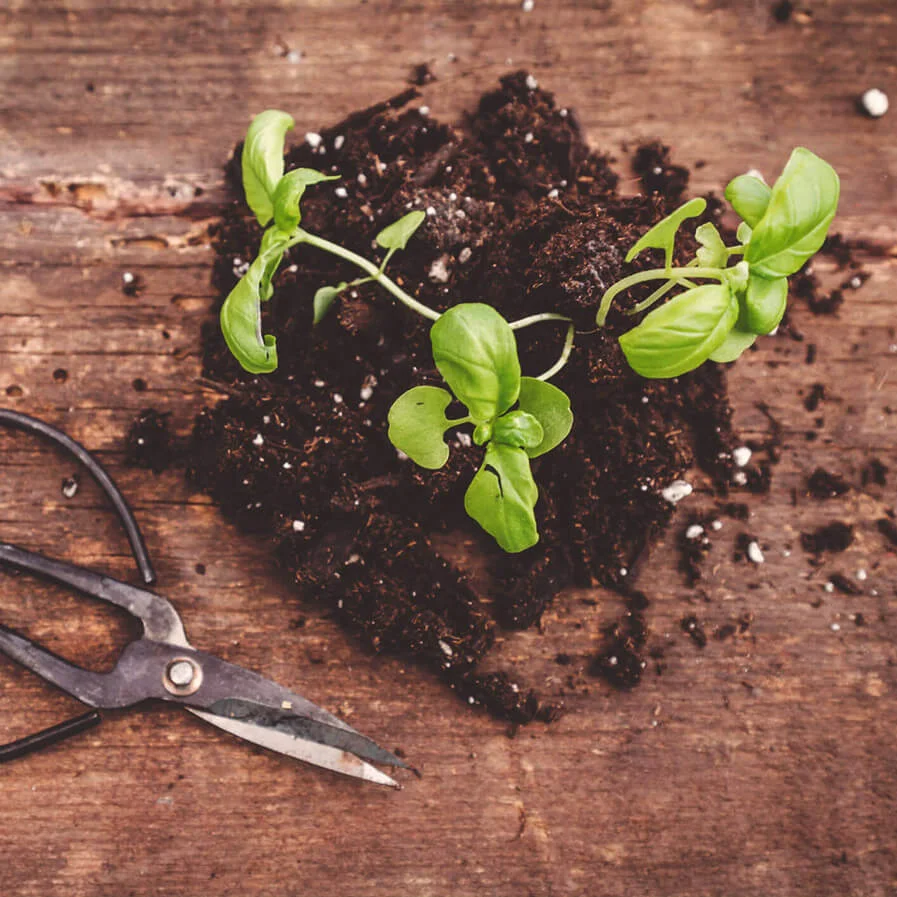
Pruning shears and basil
Here is a recap of the 10 tips to Grow the Best Basil
- Begin trimming Basil once the seedlings reach six to eight inches in height and display three to four leaf pairs.
- Consistently prune Basil during its growth period to promote further branching and increased leaf production.
- Trim a maximum of one-third of the plant in one go to ensure you don’t damage it.
- Steer clear of trimming the plant’s woody section close to its base to safeguard against harm.
- Trim the plant before it blooms to stop it from turning woody and keep the aromatic leaves bitter.
- Pick the Basil leaves during the morning when their essential oils are most concentrated, giving the leaves their fullest taste.
- Trim Basil every 2-3 weeks to promote abundant growth.
- Employ clean, sharp scissors or garden shears to trim the basil stem.
- Trim the stem, leaving only 2 to 4 leaves intact.
- Take off the upper stem portions during harvesting rather than picking single leaves to encourage fresh growth.
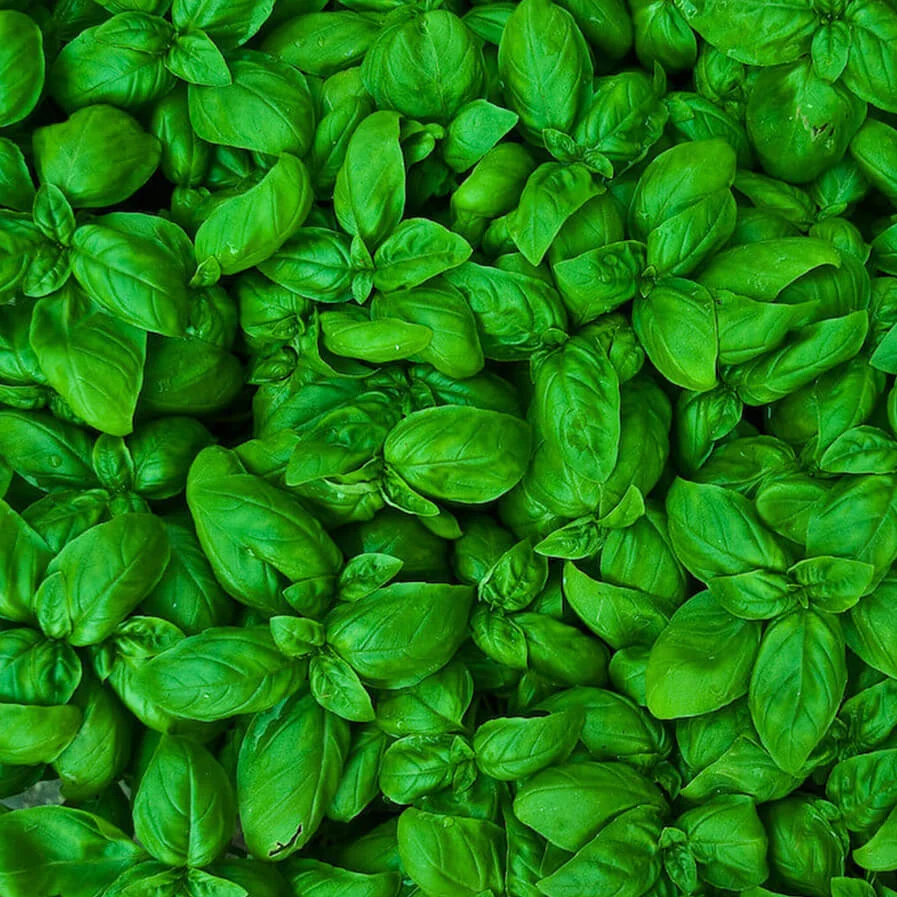
Basil
Troubleshooting Basil: Growing Problems, Pests, and Diseases
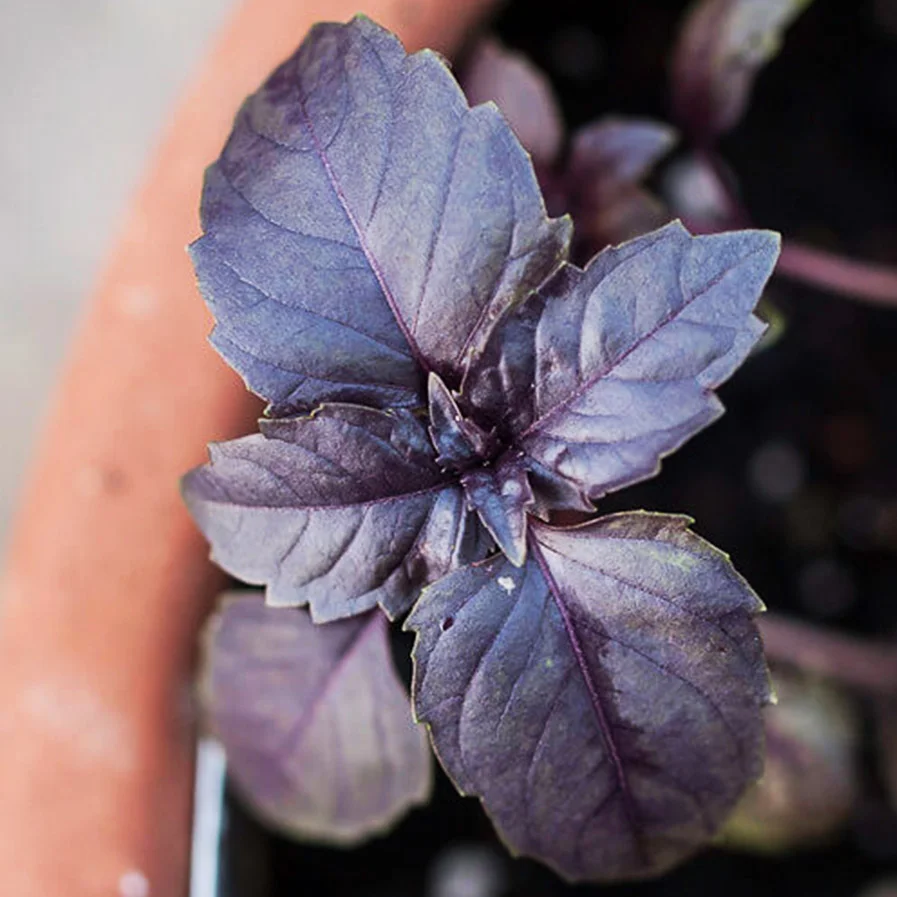
Red Rubin Basil
Growing Problems
- Basil thrives in well-drained soil and abundant sunlight, so ensure you position it in a spot receiving a minimum of six hours of direct sun daily.
- Giving the plant too much water can result in root rot, so regularly monitor the moisture and water thoroughly when the top inch dries out.
- Basil has a sensitivity to temperature changes, especially sudden drops. It’s inclined towards warmer conditions, so plant it only after the frost risk subsides to prevent it from growing elongated due to a chilly period.
- Basil might suffer from fungal issues like root rot and powdery mildew. To counteract these problems, plant it in well-draining soil and avoid over-irrigating.
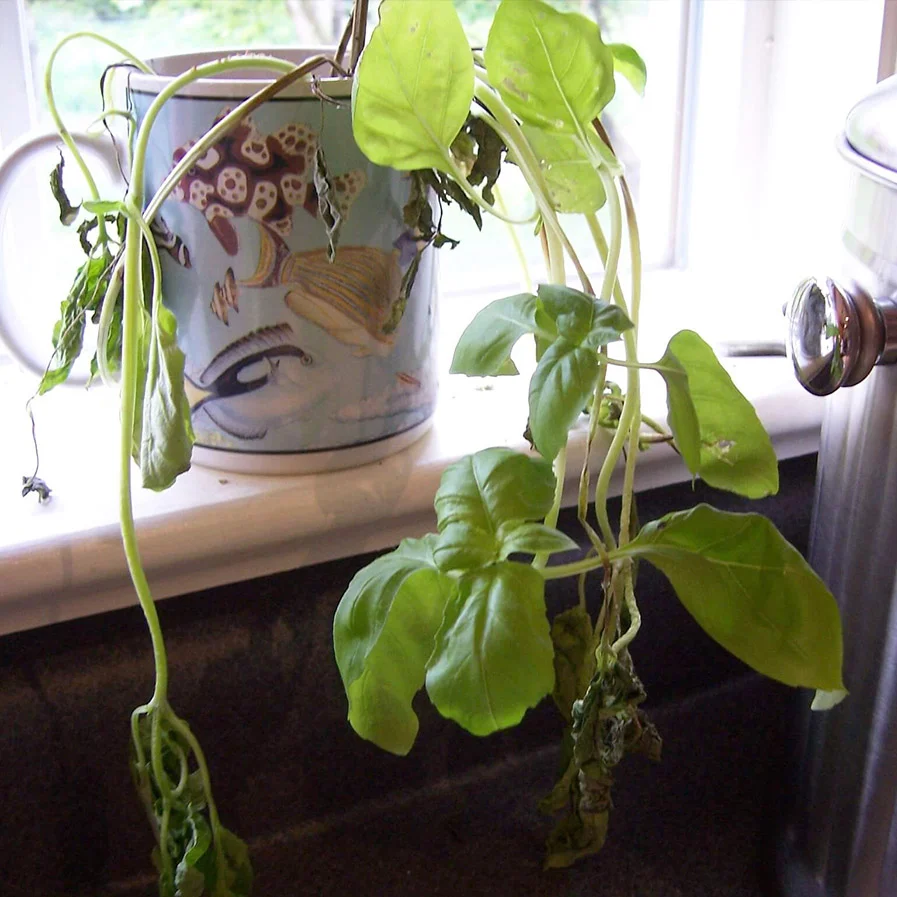
Basil with little water, little soil and in cold temperature
Pests
Basil typically resists pests, yet it might fall prey to spider mites, aphids, and whiteflies.
To deter them, ensure the vicinity of your basil plants remains neat and devoid of debris.
In the event of pest infestation, resort to insecticidal soap or neem oil for management.
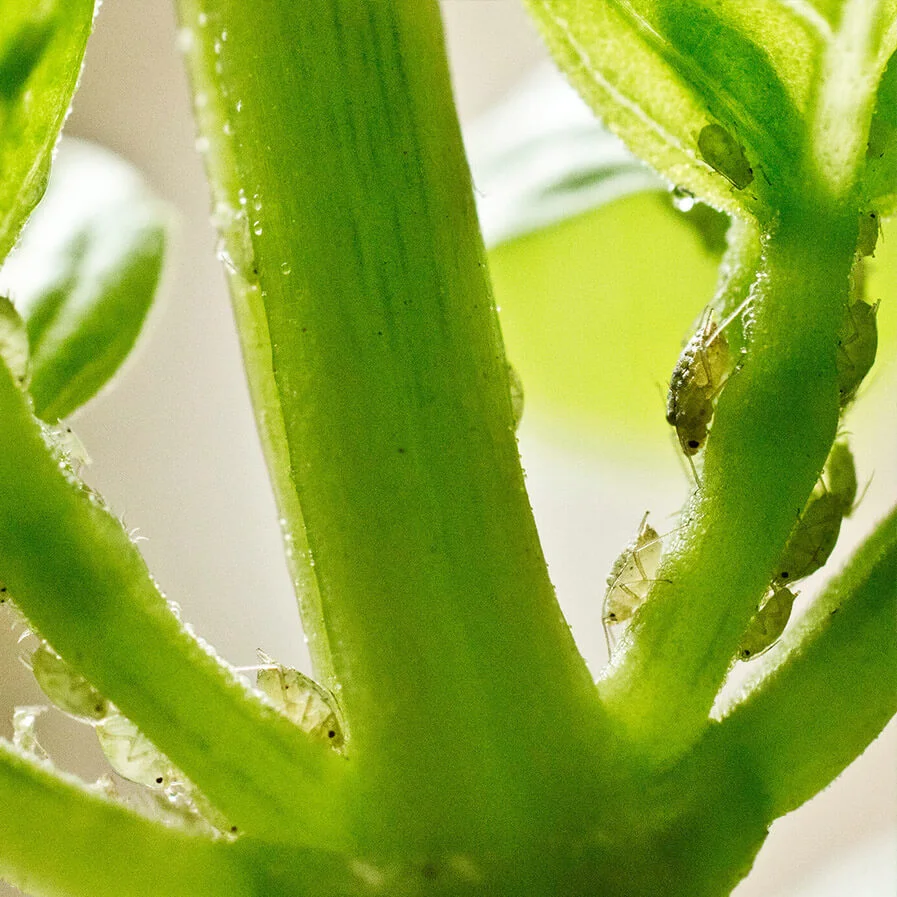
Aphids
Diseases
Basil might face fungal ailments like root rot and powdery mildew.
To safeguard against these diseases, plant Basil in soil that drains well and refrain from excessive watering.
If disease indicators like yellowing leaves or wilting become evident, extract the impacted plant and discard it to halt disease progression.
Other Problems you might run into when growing Basil
- Why are my Basil Plant’s Leaves Small? Plants that are too closely packed vie for light, moisture, and essential nutrients. Additionally, tight spacing can elevate the risk of diseases due to insufficient air movement.
- Why is the Basil Plant Wilting? Wilting, curling, or drooping of basil leaves can result from excessive or insufficient watering. Factors like diseases targeting Basil, pests infesting the plant, confinement in undersized containers, flowering, temperature fluctuations, or the shock from transplanting can also lead to wilting in Basil.
- Why is Basil Light Green? The cause might be inadequate sunlight exposure or excessive watering.
- Why Do Basil Leaves Turn Yellow? Basil leaves might turn yellow due to fungal infections like downy mildew, root rot from too much water, or exposure to cold temperatures.
- Why Do Basil Leaves Turn Brown? Brown markings or lines on the stem intensely contorted stems and leaf shedding can indicate fusarium wilt, a prevalent ailment in Basil.
- Why Do Basil Leaves Turn Black? Black markings on basil leaves might result from bacterial leaf spot. To mitigate this disease, ensure your basil plants receive ample air movement and adopt a watering method that prevents bacteria from splashing onto the foliage.
- Why is Basil Bitter? Basil might develop a bitter taste if it blooms or if cultivated in soil overly abundant in nitrogen.
- Basil with Black Spots: Bacterial leaf spots might be the reason for black markings on basil leaves.
- Basil with Brown Spots: Brown markings or lines on the stem, intensely contorted stems, and leaf shedding may indicate fusarium wilt, a widespread ailment in Basil.
- Basil with White Spots: White markings on basil leaves might arise from downy mildew, a fungal infection that worsens in excessively damp environments.
- Why is my Basil Plant Dying? Several factors, such as excessive or insufficient watering, pests, illnesses, and temperature shifts, can lead to the demise of basil plants.
Great Plants to Place next to Basil
Lavender (Lavandula spp.)
Lavender not only adds beauty to the garden but also attracts pollinators like bees and butterflies, which can benefit basil plants. Its strong scent can also help repel pests such as mosquitoes and moths.
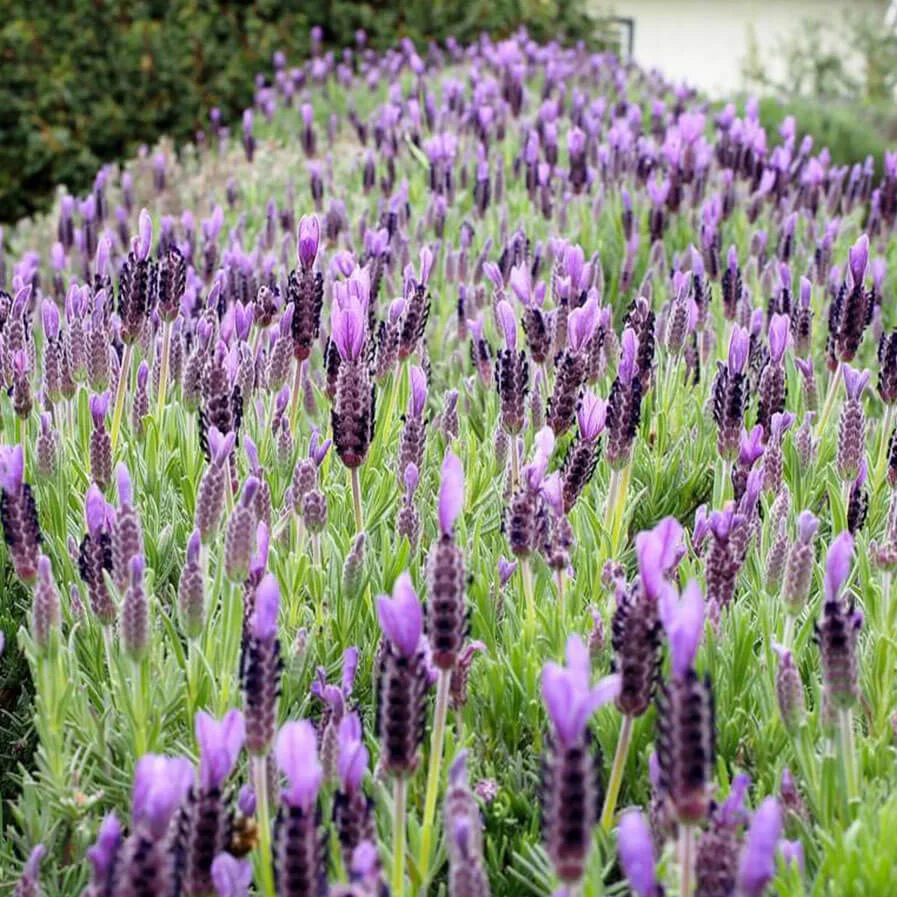
Lavender plant hedge
Tomatoes (Solanum lycopersicum)
Basil and tomatoes make excellent companions in the garden and the kitchen. Basil can enhance the taste of tomatoes and repel pests like aphids, whiteflies, and tomato hornworms.
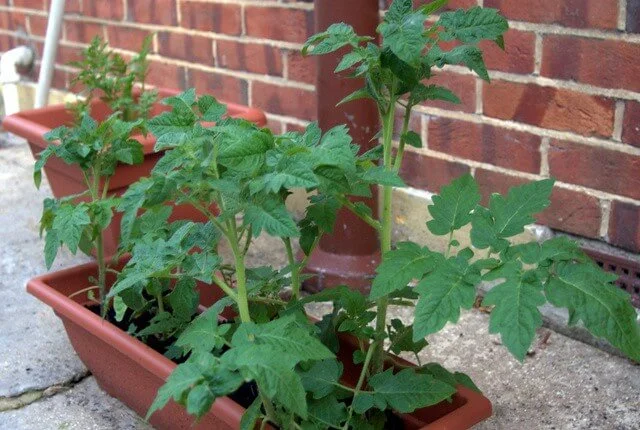
Tomato plant
Oregano (Origanum vulgare)
Oregano and basil are aromatic herbs with similar growing requirements. Planting them together can create a fragrant and flavorful herb garden and promote beneficial insect activity.

Oregano in a container
Peppers (Capsicum spp.)
Peppers and basil are complementary in flavor and can benefit from being grown together. Basil can help deter pests like aphids, spider mites, and thrips commonly affecting pepper plants.
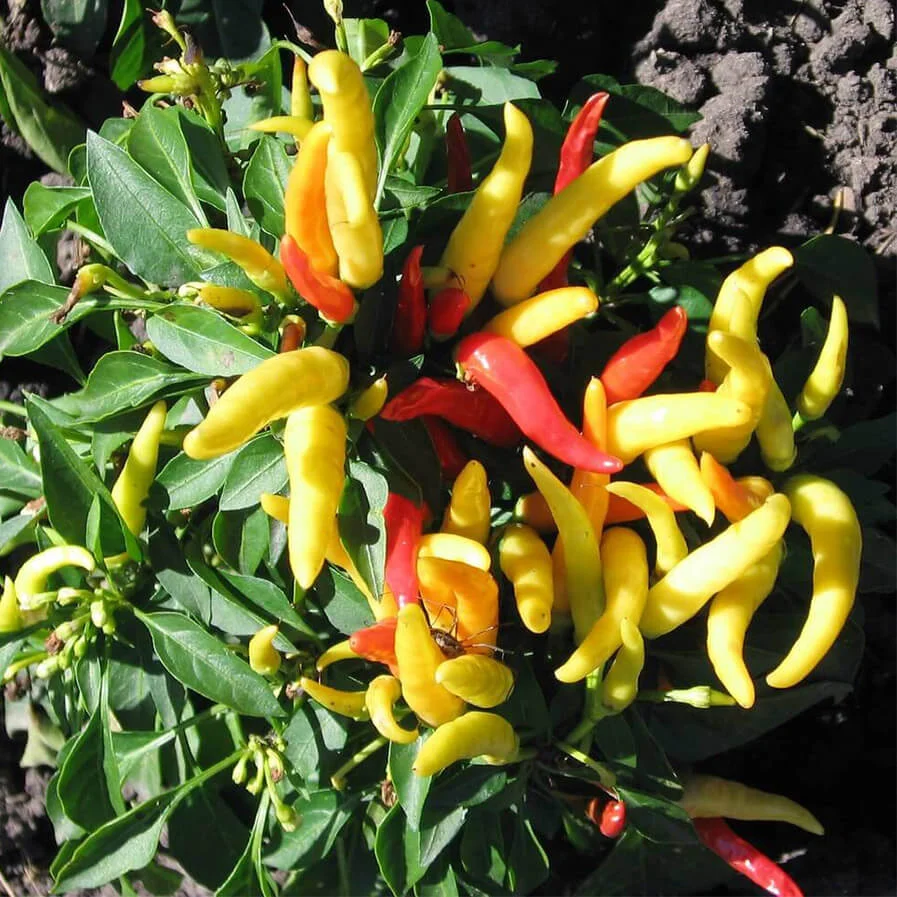
Peppers plant
Marigolds (Tagetes spp.)
Marigolds are known for their pest-repelling properties and can help deter nematodes, aphids, and other pests that may affect basil. Planting marigolds around basil can create a protective barrier.

Marigolds
Chives (Allium schoenoprasum)
Chives are beneficial companions to basil, as they can help deter pests like aphids, spider mites, and thrips. Additionally, chives’ oniony flavor complements basil well in culinary dishes.
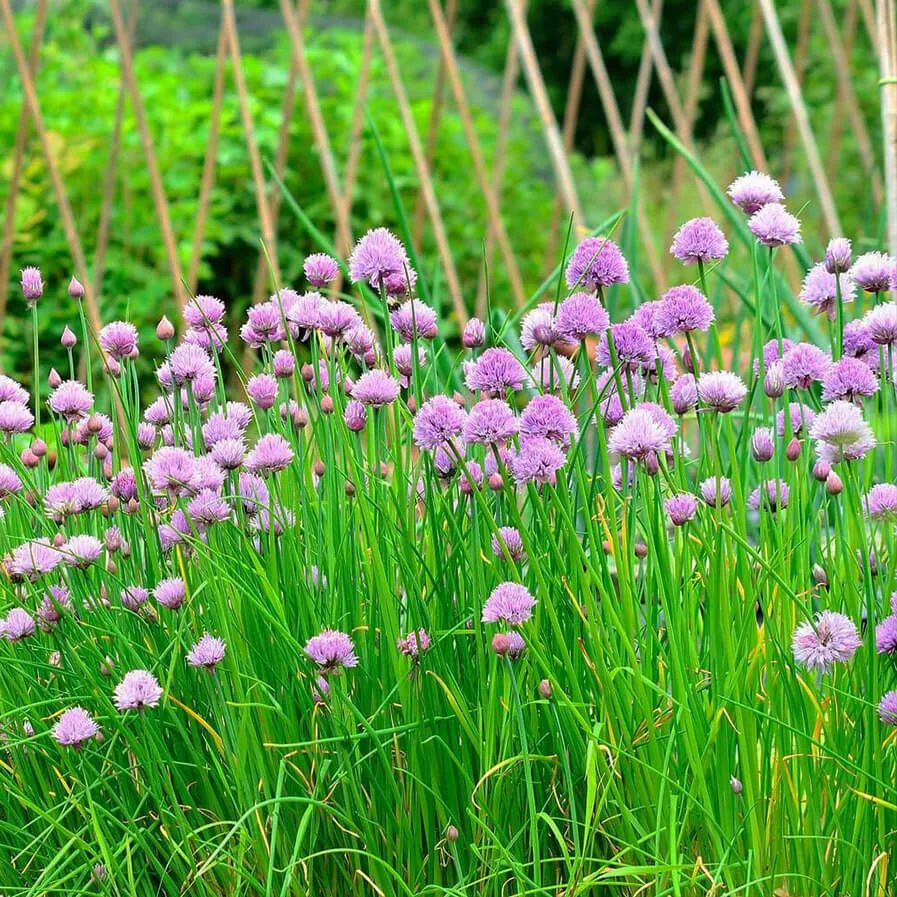
Chives
Nasturtiums (Tropaeolum majus)
Nasturtiums are edible flowers that attract beneficial insects like predatory beetles and hoverflies, which prey on common basil pests. They also have a peppery flavor that complements basil in salads and other dishes.
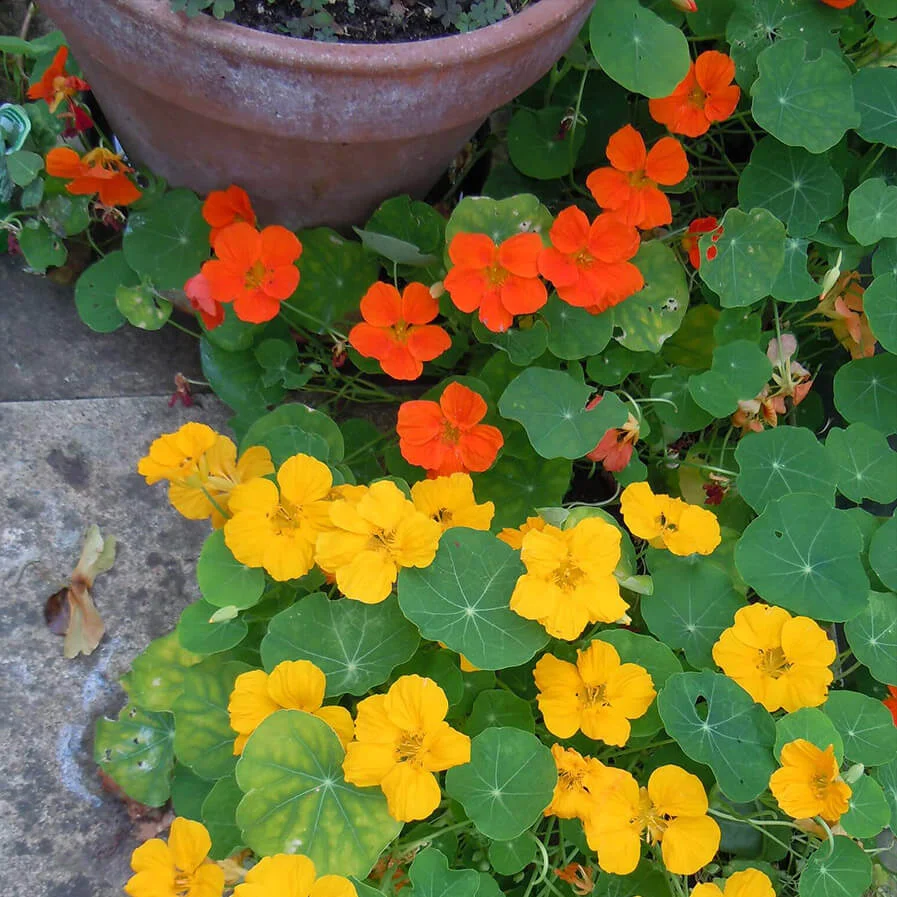
Nasturtiums
Plants to avoid planting next to basil
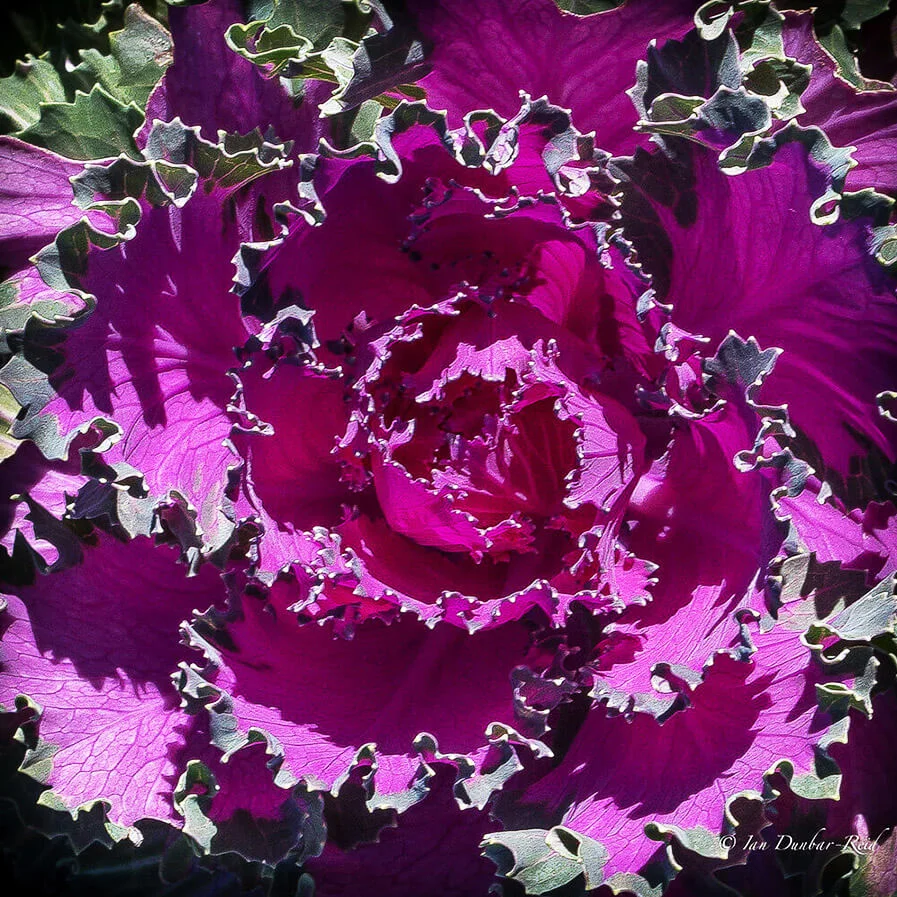
Cabbage (Brassica)
- Fennel (Foeniculum vulgare): Due to its allelopathic properties, it may hinder nearby plants’ growth.
- Rue (Ruta graveolens): Rue contains compounds that can be detrimental to the growth of nearby plants, including basil. It’s best to keep them separated to prevent potential stunting or damage.
- Anise (Pimpinella anisum): Anise has allelopathic properties that may hinder the growth of nearby plants. Planting them together may result in poor growth or flavor development.
- Cabbage Family (Brassicaceae): Plants from the cabbage family, such as cabbage, broccoli, and cauliflower, can compete with basil for nutrients and may also attract pests that could damage basil plants.
- Mint (Mentha spp.): While most people recommend mint as a companion plant to repel pests, it can become invasive and overtake basil if planted too closely. It’s best to keep mint contained in pots or separate garden areas.
Other plants similar to Basil
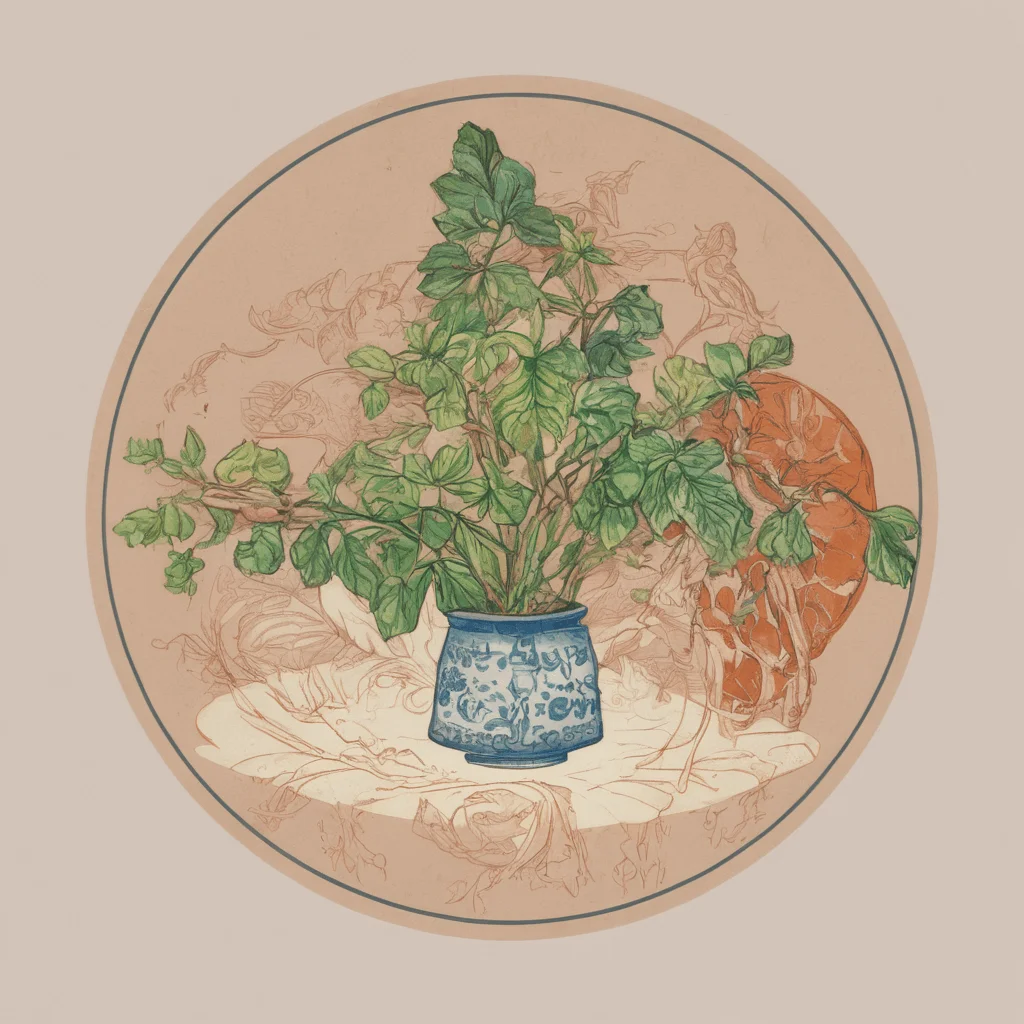
Basil Allegory
Credit Alberto Conde, Kitchen In The Med
- Mint (Mentha spp.)
- Cilantro, or coriander (Coriandrum sativum)
- Parsley (Petroselinum crispum)
- Oregano (Origanum vulgare)
- Thyme (Thymus vulgaris)
- Rosemary (Rosmarinus officinalis)
- Sage (Salvia officinalis)
Basil, compared to other popular plants and condiments
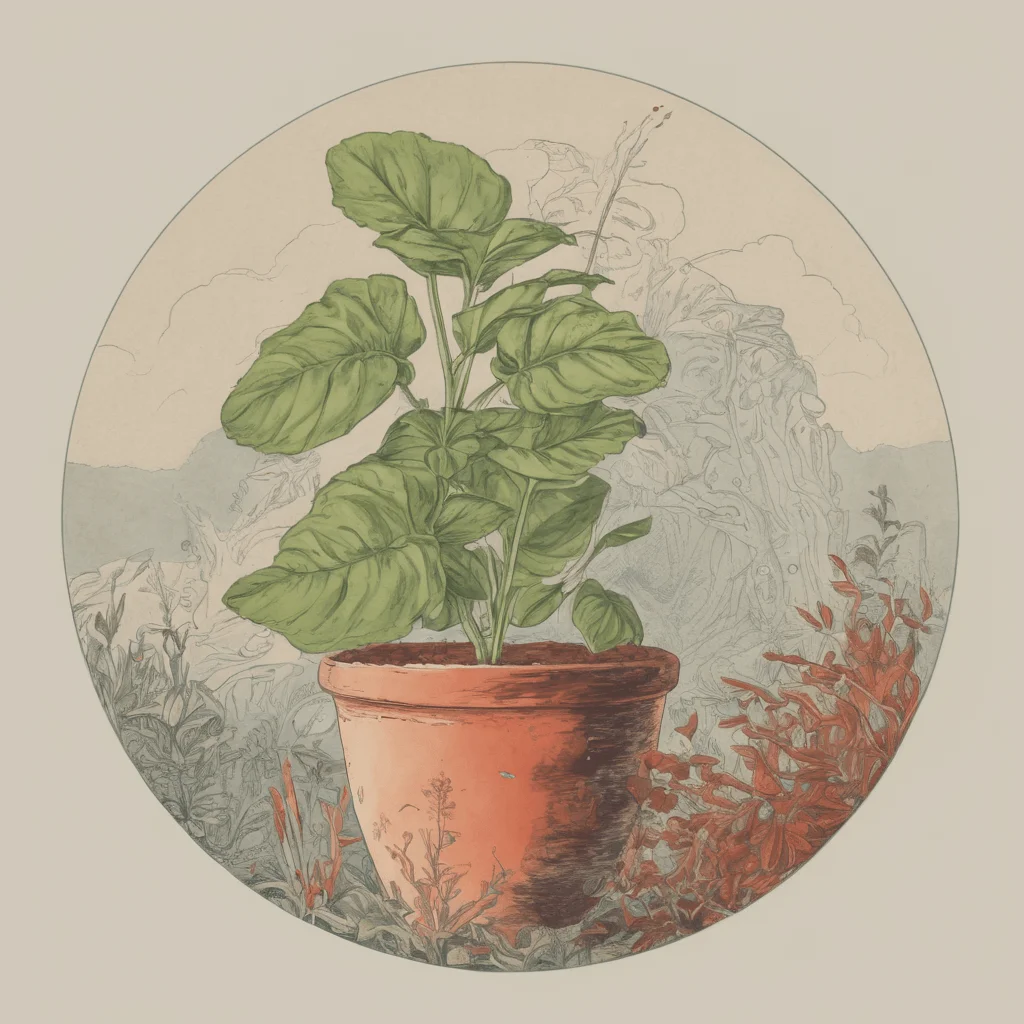
Basil Allegory
Credit Alberto Conde, Kitchen In The Med
Basil
- Growing conditions: Basil favors warm, sunny locations with well-draining soil and prospers in Mediterranean climates.
- Characteristics: Basil has a sweet, peppery savor with large, tender leaves varying from green to purple. It’s very popular in Italian dishes, pesto, salads, and garnish.
Cardamom
- Growing conditions: Cardamom flourishes in warm, humid climates with spotted sunlight and well-draining soil.
- Characteristics: Cardamom has a warm, citrusy taste with floral undertones. The little green pods have a papery outer shell. People use it in curries, desserts, and beverages.
Lavender
- Growing conditions: Lavender prefers full sun and well-draining soil, prospering in Mediterranean-like conditions.
- Characteristics: Lavender has a floral, slightly sweet taste with hints of citrus and pine. People use it to infuse syrups, baking, or garnish desserts for its fragrant aroma.
Thyme
- Growing conditions: Thyme thrives in sunny areas with well-draining soil and is drought-tolerant.
- Characteristics: Thyme has an earthy, slightly peppery, and lemony taste, with little gray-green leaves. People use it in soups, stews, roasts, and marinades.
Rosemary
- Growing conditions: Rosemary likes full sun and well-draining soil, and it’s drought tolerant.
- Characteristics: Rosemary has a piney, resinous flavor with needle-like dark green leaves. It is popular in roasts, grilled meats, marinades, and bread.
Oregano
- Growing conditions: Oregano prospers in full sun with well-draining soil and is drought-tolerant.
- Characteristics: Oregano has a bold, intense, and scarcely bitter flavor with little green leaves and groups of white flowers. It’s a staple herb in Mediterranean cuisine, used in pizzas, pasta, salads, and marinades.
Sage
- Growing conditions: Sage likes full sun and well-draining soil, and it’s drought tolerant.
- Characteristics: Sage has an earthy, peppery, and savory taste with fuzzy gray-green leaves. People use it in stuffing, poultry dishes, sauces, and roasted vegetables.
Black Pepper
- Growing conditions: Black pepper thrives in warm, humid climates with well-draining soil and requires support for its climbing vines.
- Characteristics: Black pepper has an intense, spicy, and slightly floral taste with little round berries that turn black when dried. It’s prevalent worldwide to add heat and depth to savory dishes.

Basil Allegory
Credit Alberto Conde, Kitchen In The Med
The most frequently asked questions about growing Basil
How long does a basil plant last?
With appropriate care, Basil can thrive for 4-6 months.
Does Basil need direct sunlight?
Absolutely, Basil requires a minimum of 6 hours of direct sun daily.
Why is my basil plant drooping?
Basil plants might wilt because of too much water, insufficient watering, or intense sunlight exposure.
Are basil flowers edible?
You can eat basil flowers and incorporate them into dishes or use them for garnishing.
How often should I water my basil plant?
Water basil thoroughly when the top inch of soil dries out, typically every week.
How often should I fertilize my basil plant?
Feed Basil monthly using a water-soluble plant nutrient or a gradual-release organic fertilizer.
When should I prune my basil plant?
Begin trimming Basil once the seedlings reach six to eight inches (15 to 20cm) in height and display three to four pairs of leaves.
How do I prune my basil plant?
Utilize clean, sharp scissors or garden shears to trim the basil stem. Snap off the uppermost branches to encourage additional side growth and achieve a more elevated plant.
Can I grow Basil indoors?
You can grow Basil indoors with at least 6 hours of direct sunlight or bright artificial light daily.
What is the best soil for growing Basil?
It flourishes in well-draining soil with a pH level between 6.0 and 7.0. Enhance the soil quality by incorporating abundant organic nutrients from sources like compost, blood meal, or cottonseed meal.
How do I prevent pests from attacking my basil plant?
Maintain a tidy environment around your basil plants, devoid of debris. If pests become a concern, employ insecticidal soap or neem oil to manage them.
How do I prevent diseases from affecting my basil plant?
To deter fungal issues like root rot and powdery mildew, plant basil in soil that drains effectively and be cautious not to overwater.
How do I harvest basil leaves?
Pick basil leaves during the early hours when their essential oils are most potent, maximizing their taste. When harvesting, opt to snip off upper stem portions rather than isolating single leaves, fostering fresh growth.
Can I freeze basil leaves?
Absolutely, you can freeze basil leaves in olive oil for consumption throughout the colder months.
How do I dry basil leaves?
Snip the branches you want, wash them with cool water, and let them sit in a warm, dry spot until thoroughly dried. Keep them in a sealed container.
With appropriate care, Basil can thrive for 4-6 months.
Absolutely, Basil requires a minimum of 6 hours of direct sun daily.
Basil plants might wilt because of too much water, insufficient watering, or intense sunlight exposure.
You can eat basil flowers and incorporate them into dishes or use them for garnishing.
Water basil thoroughly when the top inch of soil dries out, typically every week.
Feed Basil monthly using a water-soluble plant nutrient or a gradual-release organic fertilizer.
Begin trimming Basil once the seedlings reach six to eight inches (15 to 20cm) in height and display three to four pairs of leaves.
Utilize clean, sharp scissors or garden shears to trim the basil stem. Snap off the uppermost branches to encourage additional side growth and achieve a more elevated plant.
You can grow Basil indoors with at least 6 hours of direct sunlight or bright artificial light daily.
It flourishes in well-draining soil with a pH level between 6.0 and 7.0. Enhance the soil quality by incorporating abundant organic nutrients from sources like compost, blood meal, or cottonseed meal.
Maintain a tidy environment around your basil plants, devoid of debris. If pests become a concern, employ insecticidal soap or neem oil to manage them.
To deter fungal issues like root rot and powdery mildew, plant basil in soil that drains effectively and be cautious not to overwater.
Pick basil leaves during the early hours when their essential oils are most potent, maximizing their taste. When harvesting, opt to snip off upper stem portions rather than isolating single leaves, fostering fresh growth.
Absolutely, you can freeze basil leaves in olive oil for consumption throughout the colder months.
Snip the branches you want, wash them with cool water, and let them sit in a warm, dry spot until thoroughly dried. Keep them in a sealed container.
Main Sources I used in This Article
University of Minnesota Extension
Research Gate
Advances in Environmental Biology, 5(5): 956-960, 2011
ISSN 1995-0756
University of Nottingham, UK
ScienceDirect
Agricultural Water Management, Volume 238, August 2020, 106203
Utah State university
The Royal Horticultural Society
Universita’ di Torino, Italy
Advances in Environmental Biology, 5(5): 956-960, 2011
ISSN 1995-0756
Nutrient Supply and Fertilization of Basil
Agricultural Water Management, Volume 238, August 2020, 106203
How to Grow Basil in Your Garden
How to Grow Basil Plants: The Complete Guide
Home & Garden Information Center